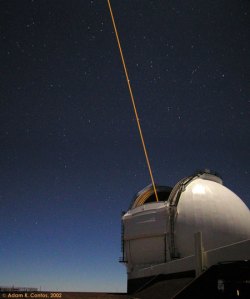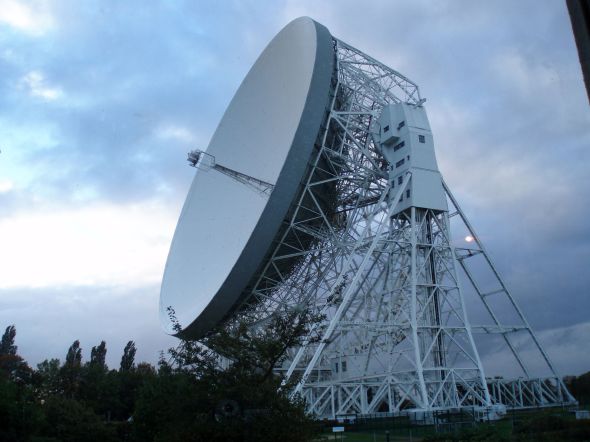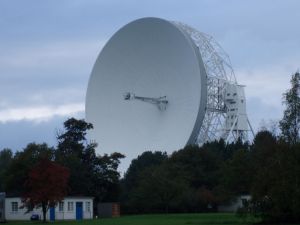Backstage science – the telescope with 24 eyes
Posted: November 8, 2011 Filed under: Uncategorized | Tags: Backstage science, KMOS, spectrograph, telescope, vlt 2 CommentsKMOS, the K-band Multi-Object Spectrometer, is a huge instrument for a Very Large Telescope in Chile. It’s currently being built and tested at the Astronomy Technology Centre in Edinbugh by, amongst others, my friend Michele. I’ll let him tell you all about it:
Observatory life
Posted: January 30, 2011 Filed under: Uncategorized | Tags: Australian Open, Hawaii, jcmt, mauna kea, telescope, tennis 2 Comments[tweetmeme only_single=false service=wp.me source=allinthegutter]
Hello again from the top of Mauna Kea. It’s night 5 of my 7 night run using the James Clerk Maxwell Telescope (JCMT) and it’s all going pretty smoothly so far. The main effect of the altitude on me so far is sneezing, which I am doing with annoying frequency. If you want to find out more about what I’m doing up here check out my first mountain post here.
This is the JCMT, taken with the camera on my phone (ensuring it was in airplane-safe mode so it didn’t interfere with any observations). Annoyingly for you, I forgot the cable to transfer photos from my digital camera to my laptop so you’re all stuck with the slighly more rubbish ones. Yesterday the telescope operator took me up on the roof to look at the view, and we walked round the overhanging walkway.
The JCMT lives in Submillimeter Valley, which is below the ridge where the optical and infrared telescopes are. This gives me the ideal opportunity to take odd photos featuring me and the Subaru (left) and one of the two Keck (right) telescopes:
The telescope control room is a pretty relaxed place. Modern telescopes like the JCMT are so complex that astronomers like me aren’t allowed to move them ourselves. All we have to do is pick the next thing to look at and then the Telescope Operator does all the hard work. However, since each observation takes up to an hour to complete there’s lots of time for doing other things like blogging or watching Andy Murray in the Australian Open Final. We even got a mention on the BBC!
I’m aiming to do one more mountain post on my last night (tiredness permitting), in which I’ll try and explain more about the science I’m trying to do up here. Well, that or I’ll just post some more photos!
Hello from the mountain
Posted: January 26, 2011 Filed under: Uncategorized | Tags: jcmt, mauna kea, observing, telescope 1 Comment[tweetmeme only_single=false service=”wp.me” source=”allinthegutter”]
It’s just past 4am Hawaiian time (about 2pm GMT) on my first night of observing and I need something to help me stay awake so I’m writing this post. I’m at the James Clerk Maxwell Telescope (JMCT) on Mauna Kea, 13,796 ft above sea level. Becuase it’s so high, being up here is pretty difficult – you can really feel the lack of oxygen and you have to be constantly on the alert for the symptoms of altitude sickness. Mainly I’m trying not to move around too much! The control room of the JCMT, where I sit, rotates with the telescope so every now and then it starts rocking. It’s a bit disconcerting but I think I’m getting used to it. The biggest problem is that the toilet moves as it’s on the non-moving floor downstairs, and it can take a while to find it!
I’m here to map the clouds of molecular hydrogen in 50 nearby galaxies using the HARP-B instrument. However, this gas is really difficult to detect directly so what I’m actually measuring is carbon monoxide, which tends to hang out in the same clouds.
 People are only allowed to spend 14 hours out of every 24 up here at the summit, so we all stay at a dormitory complex called Hale Pohaku down at 9,300 ft. It takes about 40 minutes to drive up to the summit, mainly because the first section of the road isn’t paved. We didn’t come up to the telescope until 7:30pm tonight so it was already dark when we set off, meaning we had a beautiful view of the night sky all the way. I was also lucky enough to see the zodiacal light, which comes from sunlight reflecting off dust in the Solar System. You need a very dark site, with no moon or light pollution to get a glimpse of it because it’s so faint. I didn’t have the right camera to get a photo of it myself but the picture on the left, taken at an observatory in Chile, shows it well.
People are only allowed to spend 14 hours out of every 24 up here at the summit, so we all stay at a dormitory complex called Hale Pohaku down at 9,300 ft. It takes about 40 minutes to drive up to the summit, mainly because the first section of the road isn’t paved. We didn’t come up to the telescope until 7:30pm tonight so it was already dark when we set off, meaning we had a beautiful view of the night sky all the way. I was also lucky enough to see the zodiacal light, which comes from sunlight reflecting off dust in the Solar System. You need a very dark site, with no moon or light pollution to get a glimpse of it because it’s so faint. I didn’t have the right camera to get a photo of it myself but the picture on the left, taken at an observatory in Chile, shows it well.
When we reached the summit, most of the other telescopes up here had already opened up and started working. This meant that I got to see the Keck artificial guide star laser, that I’ve blogged about before, shooting up into the sky.
It’s nearly 5:30am now so I’d better wrap this up before I get too tired to write straight. I’ll be up here for another 2.5 hours tonight, and then for the next 6 nights after that, so this probably isn’t the last post from the mountain. If you’ve got any questions about what’s it’s like up here please leave them in the comments and I’ll try to answer them in as coherent a way as possible!
Lasers, telescopes & aeroplanes
Posted: October 30, 2009 Filed under: Uncategorized | Tags: adaptive optics, laser, telescope 3 Comments[tweetmeme only_single=false service=”wp.me” source=”allinthegutter”]
So this post was supposed to be about the discovery of the most distant galaxy ever found, at a redshift of about 8.2 (13.1 billion light years from us, or, to put it another way, only about 630 million years after the Big Bang), but I didn’t get round to it yesterday and I’ve now been distracted by a paper out today on telescopes, laser beams and aeroplanes instead! (For more details on the distant galaxy see this post over at the always excellent In the Dark. There’s a lot of effort being put into this field at the moment, as already discussed here by Rita, so I expect there’ll be a new ‘most distant’ one that I can catch up with soon.)
One of the main problems astronomers face when trying to observe things in the sky is the turbulence in the Earth’s atmosphere, from clouds, wind etc (this is known as ‘seeing’ and is what causes the stars to twinkle). To get away from this telescopes are normally built high up on mountains, above as many of the clouds as possible, or, like the Hubble Space Telescope, put into orbit where there’s no atmosphere to worry about.

Putting a telescope on a mountain doesn’t completely avoid all the atmospheric distortions, but a technique called adaptive optics can help to correct it. This needs a nice bright star in the field of view, but when this isn’t available an artificial star can be created by shooting a laser beam into the sky, as shown for the Keck Telescope in the picture above. The telescope then observes this ‘star’, and uses its fluctuations in shape (due to the current patch of atmosphere overhead at the time) to correct the astronomical images as they are observed. I should add here that this isn’t the only time lasers are used alongside telescopes – for example they are also fired at the reflectors left on the moon by the Apollo missions, as I’ve blogged about before.

The benefit of adaptive optics for a galaxy observed at the Canada-France-Hawaii Telescope. Left: with correction, right: without
The only flaw in this telescopes-lasers-great corrected, pictures of the sky/laser ranging plan is aeroplanes. Laser beams can dazzle pilots so understandably they can’t be used at the telescopes when planes are in the vicinity. What this has meant in practice up till now is someone sitting outside all night, ready to close the laser-shutter when one comes too close. Not very practical and a pretty boring job! Well, now some researchers in California have come up with a solution. Aviation regulations require that all aircraft are fitted with transponders so that they can be tracked by air-traffic control. By measuring the ratio of transponder signal power from two antennae aligned with the laser, one broad and one narrow beam, the position of the aircraft can be found. An automated shutter can then be activated to turn the laser off, and the cold plane-watchman can go back inside.
![]() W. A. Coles, T. W. Murphy Jr., J. F. Melser, J. K. Tu, G. A. White, K. H. Kassabian, K. Bales, & B. B. Baumgartner (2009). A Radio System for Avoiding Illuminating Aircraft with a Laser Beam submitted to PASP arXiv: 0910.5685v1
W. A. Coles, T. W. Murphy Jr., J. F. Melser, J. K. Tu, G. A. White, K. H. Kassabian, K. Bales, & B. B. Baumgartner (2009). A Radio System for Avoiding Illuminating Aircraft with a Laser Beam submitted to PASP arXiv: 0910.5685v1
That’s for Jan Brueghel the Elder…….
Posted: September 28, 2009 Filed under: Uncategorized | Tags: flemish painters, history of astronomy, Jan Brueghel the Elder, telescope 6 Comments[tweetmeme only_single=false service=”wp.me” source=”allinthegutter”]
OK so yet again I’m blogging on a topic I don’t know terribly much about but that I found interesting. A month ago this paper by Paolo Molaro and Pierluigi Selvelli from Trieste Observatory appeared outlining the interesting case of early telescopes in paintings.
The paper focusses on the work of Jan Brueghel the Elder and in particular two works made between 1608 and 1617. My knowledge of Flemish painters is limited to Jan van Eyck and Hieronymus Bosch (and most if the latter comes from watching In Bruge) so forgive me if I can’t discuss the finer technical points of the art, there does appear however that there could be be a fascinating story behind the paintings.
In the early 17th century the Eighty Years’ War had reached stalemate. Most of what is now The Netherlands was held by the new Dutch Republic while their Spanish opponents and former overlords remained in control of Flanders to the south. It was in this environment that the telescope was first invented. Who invented it is not certain, but we do know that the first public demonstration was in Den Haag in 1608.
Around this time Jan Brueghel the Elder was working as the court painter for Archduke Albert VII (the sovereign of the Spanish/Austrian portion of the Low Countries). At some time in-between 1608 and 1611 he painted “Extensive Landscape with View of the Castle of Mariemon” (I can’t find a picture online, see the original paper). In this the archduke is seen viewing the scenery through a telescope. Given the date it is likely this is one of the earliest such device. The authors then go on to speculate that this device could have been made by the inventor of the telescope. One letter from a Papal envoy to a nephew of Pope Paul V claims that, having seen the telescope being demonstrated in Den Haag while he was there negotiating a peace deal with Dutch Stadthouder Maurice of Nassau, Ambrosio Spinola (the Genoese commander of the Spanish Army in the Low Countries) was impressed and managed to obtain one of these “spyglasses”. Another letter written by a Udine nobleman (to Galileo of all people) claims this came from the inventor himself.
Brueghel also worked on a series of paintings in collaboration with Ruebens. In The Allegory of Sight (1617, see below),

he paints a long, silver telescope. The authors deduce from its style and dimensions that this instrument could be one of the first Keplerian Telescopes (one where the eyepiece as well as the objective lens is convex). These were first described in principle by Kepler in 1611 and could have been manufactured shortly after. They suggest that Christoph Scheiner, one of the first people to observe sunspots, had presented Keplerian telescopes to Archduke Albert’s brother in Innsbruck. A Keplerian Telescope produces an image which is upside down, Scheiner added a third lense to flip the image to the correct orientation. So again it is quite possible that this is one of the first ever device of its type ever made.
I hope I’ve given a reasonable run-down of a subject, if you want to know the full story from a much better source then I urge you to read the original paper. And if you understand what the title of this post is a nod to, don’t complete it in the comments thread (please).
Paolo Molaro, & Pierluigi Selvelli (2009). The mystery of the telescopes in Jan Brueghel the Elder’s paintings Memorie della Società Astronomica Italiana arXiv: 0908.2696v1
Happy Birthday The Telescope
Posted: August 25, 2009 Filed under: Uncategorized | Tags: galileo, Jodrell Bank, Lovell dish, telescope 4 Comments[tweetmeme only_single=false service=”wp.me” source=”allinthegutter”]
When I opened Google this morning it told me that today is the 400th anniversary of Galileo’s demonstration of his fancy new improved device for looking at faraway things – the telescope.**
I thought I should mark this in some way and I decided the best way to do so would be by talking about my favourite telescope, the Lovell Radio Telescope at Jodrell Bank in Manchester.

This is the Lovell. It doesn’t look much like the instrument Galileo demonstrated but it works on exactly the same principle: light (in this case in the form of radio waves) is collected and focused to make an image of some distant astronomical source. It is the third largest steerable radio dish in the world at 76.2 metres in diameter and it has been operating since it was completed in 1957. It’s construction was masterminded by Sir Bernard Lovell, back in the days when astronomers would turn up in a muddy field with a big box of wires and build their own detectors (it’s nothing like that now!)
I’ve used this telescope. At that time this meant going to visit it at Jodrell Bank to collect the images. I loved this; the office I was put in was right next to it so I could stare at it all day (not good for productivity) and I would walk around it at lunchtimes. I think the reason this is my favourite is the shear scale of it. It towers over you and can be seen for miles around. The whole thing is just such an impressive feat of engineering.
I think I’ll finish with two more pictures. This is it stowed i.e. not observing (it’s the safest position for it to be in case of high wind).

And this, with the building in the foreground, gives a good idea of what’s it’s like to stand by it and see it loom over you.

Does anyone else have a favourite?
** As has been pointed out in the comments by someone a lot more knowledgeable than me about these things, I should make it clear that Galileo didn’t invent the telescope himself. Also, Google apparently got the date wrong – see the comments for the full timeline!
Herschel can see!
Posted: June 14, 2009 Filed under: Uncategorized | Tags: Herschel, telescope Leave a comment[tweetmeme only_single=false service=”wp.me” source=”allinthegutter”]
The Herschel Space Observatory, launched last month, achieved an important milestone this morning when the command to fire the bolts holding down the cryocover appears to have been executed successfully. The cover has been protecting the three science instruments from being contaminated during (and shortly after) launch. If this had failed the telescope would be blind (known in the trade as a ‘single point failure’), making it a tense moment for everyone involved in the project! There’s still a lot of work to be done in commissioning and testing though until the telescope can start its routine operations, but this is a very important step on the way.
There’s a neat video on youtube which shows what would have happened in slow motion.




